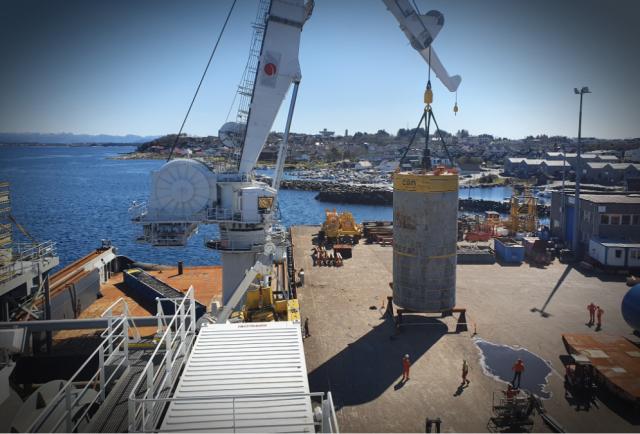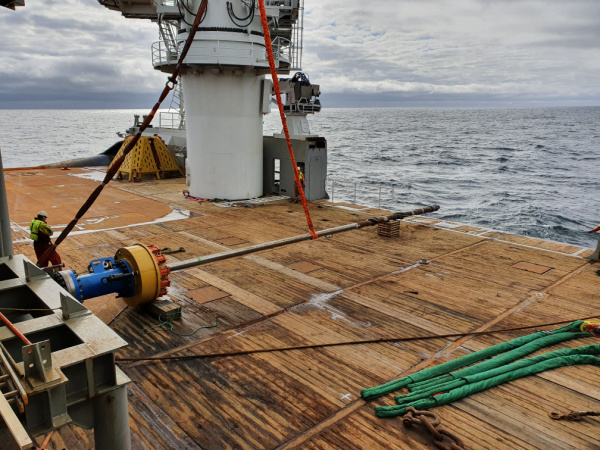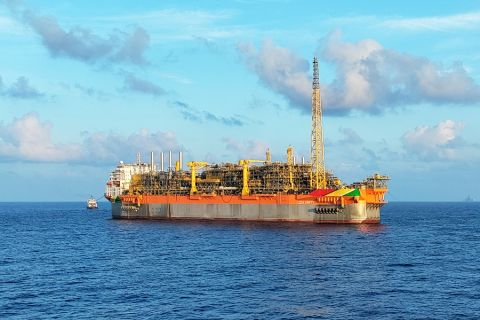
Neodrill’s CAN-ductor after retrieval. (Source: Neodrill)
Neodrill, in collaboration with Baker Hughes, undertook the world’s first ever cut-and-recover operation on Wintershall DEA’s Toutatis well in April 2020. This project was part of the abandonment phase, which was tasked with removing the Conductor Anchor Node (CAN) from the seabed. The goal of the project was to undertake operations in a manner that had the biggest reduction on environmental impact. The results proved the operation was a success; emissions were significantly reduced due to the use of the vessel over the rig, with 12 hours of rig time removed from the project.
Toutatis
Toutatis is an exploration well located in in the Norwegian Sea. It is located about 150 km northeast of the Norne field and was the first exploration well to be drilled in the area.
Due to the important environmental profile of the area, reducing emissions and environmental impact were the main considerations for Windershall DEA throughout well planning and operations.
The use of the CAN technology ensured that the greenest possible technology was used on the tophole section of the well. The CAN was originally installed in the field in June 2019, and successfully removed about three days from the rig schedule during top-hole activity. Wintershall DEA wanted to further improve the project’s green credentials and remove as many rig days as possible from the project. As such, the combination of the new Baker Hughes cutting tool and Neodrill was selected for the CAN’s removal.
The CAN technology
Adapting a traditional suction anchor and a conventional conductor, Neodrill’s CAN technology represents a merger between marine and drilling technologies to create a structural foundation that replaces the traditional conductor, known as the CAN-ductor.
Developed to facilitate the installation of the CAN-ductor, pre-rig, smaller marine vessels can be used for installation and recovery. Instead of drilling a 36-in. hole, running the conductor and carrying out cementing operations, a vessel is used to install the CAN-ductor ahead of the rig arrival. This process typically reduces the rig drilling schedule by 2-4 days, and removes the top-hole construction off the critical path for the drilling rig.
The CAN recovery project
The goal of the project was to recover the CAN-ductor from the well site. Every effort was made to reduce emissions and utilize synergies at all points in the project. The vessel Olympic Zeus was selected by Wintershall DEA to undertake the project.
The use of the cut-and-recover operation enabled the rig to abandon the well site as soon as the cement plugs were in place, immediately having an impact on cost and emissions. The Baker Hughes cutting tool was deployed and landed on the wellhead. The cutting tool is based on a standard cutting tool, modified to be utilized by crane wire and powered by an ROV. It features a hydraulicly operated motor for rotation and a water pump. The pump generates the required pressure to engage the carbide cutting knives to cut the surface casing.

A combined offshore campaign to cut the surface casing and recover the CAN-ductor unit reduces rig time, saves cost and results in fewer emissions. As such, Neodrill’s new cut-and-recover system, which uses Baker Hughes cutting tool, was selected for the CANs removal. This optimized process removed the need for unnecessary, expensive rig time in the abandonment phase. At this point in the process, the operation would revert to a normal CAN recovery.
Results
In total, rig time was reduced by an estimated 12 hours, with work to cut the surface casing moved off the critical path of the rig schedule. However, there were a number of other key benefits of this new process being utilised.
Cutting environmental impact is the main challenge for all operators across all regions, and operators will continue to ask how projects can further reduce their environmental impact.
Neodrill’s technology features Life Cycle Assessment reports carried out on prior CAN installations. The reports examined eight environmental impact categories, including climate change and human toxicity. The findings show that the environmental impact of the CAN-ductor is between 21% and 44% less than that of a conventionally drilled top-hole section.
Results showed that the typical reduction of rig time is four days. The decreased need for materials, such as cement and steel in well casings, contribute to additional environmental benefits.
The challenge for the Toutatis project was to build on the environmental considerations of the technology by combining it with the new process for cut-and-recover. The reduced rig time and use of vessels cut down emissions, which deemed the project a success.
The cutting operation by vessel took less than six hours, compared to 6-12 hours for a typical cutting operation by rig. In addition, about day rate savings were achieved of between 4-5 million NOK per day for the rig compared to 300,000 NOK per day for the recovery vessel. This reduced the vessel cost for the cutting operation from about 2 million NOK to less than 100,000 NOK.
Overall the success of the project was attributed to the fact that the cutting of surface casing was performed in 6 hours with the vessel on location for just above 24 hours or all operations combined (retrieval of trawl protection structure, cutting of surface casing, retrieval and sea-fastening of CAN). This had a direct impact on the environmental impact of the operations.
The operation was performed safely without incidents or accident. The next cut-and-recover operation is scheduled to take place for a large E&P company in later this year.
About the Author:
Jostein Aleksandersen is CEO of Neodrill. He has spent more than 30 years in the oil industry, holding various positions from project engineer to CEO. He holds an MSc degree in Mechanical Engineering and a Doctorate Degree in Petroleum Engineering.
Recommended Reading
US Raises Crude Production Growth Forecast for 2024
2024-03-12 - U.S. crude oil production will rise by 260,000 bbl/d to 13.19 MMbbl/d this year, the EIA said in its Short-Term Energy Outlook.
To Dawson: EOG, SM Energy, More Aim to Push Midland Heat Map North
2024-02-22 - SM Energy joined Birch Operations, EOG Resources and Callon Petroleum in applying the newest D&C intel to areas north of Midland and Martin counties.
US Drillers Cut Oil, Gas Rigs for Fourth Week in a Row-Baker Hughes
2024-04-12 - The oil and gas rig count, an early indicator of future output, fell by three to 617 in the week to April 12, the lowest since November.
Exxon Versus Chevron: The Fight for Hess’ 30% Guyana Interest
2024-03-04 - Chevron's plan to buy Hess Corp. and assume a 30% foothold in Guyana has been complicated by Exxon Mobil and CNOOC's claims that they have the right of first refusal for the interest.
Exxon Mobil Green-lights $12.7B Whiptail Project Offshore Guyana
2024-04-12 - Exxon Mobil’s sixth development in the Stabroek Block will add 250,000 bbl/d capacity when it starts production in 2027.



